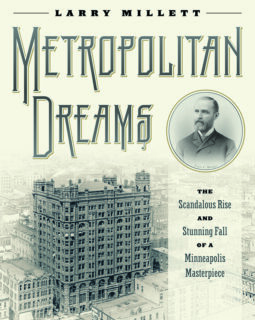Metropolitan Dreams: The Scandalous Rise and Stunning Fall of a Minneapolis Masterpiece

- Year
- 2018
- Creators
- Reviewer: Alan K. Lathrop
- Topics
Metropolitan Dreams: The Scandalous Rise and Stunning Fall of a Minneapolis Masterpiece
Author: Larry Millett
Minneapolis: University of Minnesota Press, 2018
248 pages; hardcover/cloth jacket; 140 b&w photos; $29.95
Larry Millett, author of Metropolitan Dreams: The Scandalous Rise and Stunning Fall of a Minneapolis Masterpiece, has done an excellent job chronicling the creation, life, and death of a truly iconic Minneapolis building, the Metropolitan (originally Northwestern Guaranty Loan), which stood for seventy years in the heart of downtown. Perhaps the loss of no other structure in the Twin Cities has been as deeply mourned by the public as has this building. It rightfully deserves to be lovingly remembered, just as those who were responsible for its loss deserve the opprobrium of preservationists and the general citizenry.
Millett traces the history of this landmark structure from its planning and construction in the late 1880s, aptly telling the story of its creator, Louis F. Menage. It is ironic that such a remarkable building should have been the brainchild of a first-class financial “plunger.” Menage was the epitome of a “Gilded Age” robber baron, who built a fortune on colossal financial shenanigans that collapsed and resulted in his forced flight from justice to the jungles of Central America and his stealthy return to the United States in the early twentieth century. It is a story that has all the makings of a class B movie.
Besides providing intriguing details of the architectural features of the Metropolitan, Millett delves into the politics that led to the building’s demolition between 1961 and 1962. This reviewer recalls seeing the building in its last days in late 1961, standing dark, soot-blackened, and forlorn, looking very sad amid the rubble of lesser surrounding structures being cleared for the Gateway Center urban renewal project. The book provides ample photographs that depict the beauty and grace of the building, especially its interior light court; some of these photos appear in print after many decades. Numerous contemporary views of Lower Downtown before and after the Metropolitan was demolished are accompanied by a lively text that is informative and entertaining.
The book synthesizes a great deal of research, gleaned from many primary and secondary sources, resulting in an accurate but ultimately depressing account of how a landmark building was erected and flourished for dozens of years before falling victim to the less-than-good intentions of a few men. Sadly, although one must admit that the new buildings that replaced the Metropolitan and the rest of the blocks in Lower Downtown may be cleaner and slicker, they are not nearly as architecturally attractive or appealing or, perhaps, substantial.
Menage, whose only real claim to fame and success is the Metropolitan Building, was a wheeler-dealer in finance and real estate. His name has undoubtedly been mercifully forgotten by many, but this book brings it back in spades. From the time he arrived in raw, young Minneapolis in 1871 with boundless energy and an ego to match, Menage made it his business to accumulate a fortune in real estate, questionable loan deals, and phony commercial paper. In that regard, he was no different from many other men of his day who, in the absence of modern restrictive regulations and laws, were able to build towering fortunes largely out of bluff and hot air.
Yet, by contrast, the building that he constructed between 1888 and 1889 was rock-solid. It was as if Menage subconsciously wished to use it to demonstrate that something in his life was a sure bet, even if his paper fortune was not. The proof was the endurance of the Metropolitan, which, as Millett points out, was as strong and durable on the day that demolition began as it was on the day it opened decades earlier. The building remained a popular location for lawyers, bankers, commercial firms, and others to rent space throughout its long life.
Its end was nearly as shady as its beginning. The Minneapolis Housing and Redevelopment Agency, supported by the efforts of numerous persuasive businessmen, quietly planned, almost from the outset, that the Metropolitan would be included within the area earmarked for clearance and, therefore, fated to fall to the wrecking ball. Despite the strenuous efforts of the building’s owners and scattered preservationists, its preordained doom was never seriously threatened by the still disorganized and infant historic preservation community. Had the Metropolitan survived, along with dozens of other notable buildings in surrounding blocks, the area today would undoubtedly be a prime target of preservation and rehabilitation efforts and a popular gathering place for upscale bars, restaurants, and retail space.
The complete story of the Metropolitan has never been told until now. The book provides a compelling and highly interesting history that should revive interest in the building and the personalities involved in its creation and loss. It also can be used as an object lesson for many communities in how an architectural gem was allowed to slip away to destruction, leaving an almost unfillable gap in the fabric and memory of the community in which it stood.
Alan K. Lathrop is a retired professor and curator of the Northwest Architectural Archives at the University of Minnesota Libraries and is the author of Churches of Minnesota and Minnesota Architects: A Biographical Dictionary.
- Year
- 2018
- Creators
- Reviewer: Alan K. Lathrop
- Topics